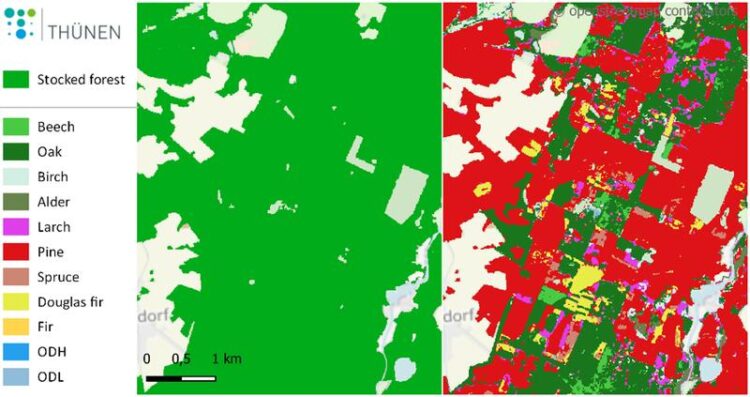Forests mapped from space

Map details on the stocked forest area (l.) and on the dominant tree species (r.) with an overview of the mapped tree species groups. ODH and ODL summarize other deciduous tree species with high or low life expectancy respectively.
(c) Thünen Institute/WO
The Thünen Institute of Forest Ecosystems publishes for the first time national forest maps of Germany based on current satellite imagery and terrestrial data from the 2012 National Forest Inventory.
The Thünen Institute now offers interactive forest maps through the Thünen Atlas (http://atlas.thuenen.de), which provide a nationwide overview of the stocked forest area – i.e. the area on which trees grow – and the dominant tree species. They are not limited to being important sources of information for public authorities, policy, NGOs and associations, but can also be used for further forest and environmental research and education.
The digital maps have a resolution of 10 m x 10 m. The map of dominant tree species is based on data from the Sentinel satellites. These satellites are part of the Copernicus Program form the European Space Agency (ESA) and are used for global environmental monitoring, for example to record changes in land use, to monitor water bodies and coasts, and to collect satellite-based climate data. The nationwide consistent data sample from the 2012 National Forest Inventory (http://www.bundeswaldinventur.de/en) and the 2017 Carbon Inventory were used for tree species classification and for the comprehensive statistical validation of the maps.
Satellite data thus provide valuable complementary information for monitoring current forest state and forest development. However, the level of detail on forest ecosystems required by policymakers and society goes beyond what is observable from the satellite. The main source of information on our forests will therefore continue to be terrestrial inventories such as the National Forest Inventory, the Carbon Inventory and the National Forest Soil Inventory.
Stocked forest area map 2018
(https://atlas.thuenen.de/layers/geonode:fnews_holzbodenmaske_2018_32632)
The 2018 stocked forest area map represents the area covered by forest trees in 2018. It provides the framework for further forest related remote sensing analyses like tree species or biomass mapping, but also for identifying future changes in stocked forest area. For this purpose, it is planned to update the “stocked forest area map” at regular intervals, provided there is respective funding.
A consistent definition of forest area is the basis for remote sensing-based forest area mapping. The Copernicus Earth Observation program builds on the international FAO forest definition. In contrast, the map produced at the Thünen Institute of Forest Ecosystems uses the forest definition by the German National Forest Inventory, which has been optimized on the national level. The map is validated with data from the 2017 Carbon Inventory and has an overall accuracy of greater 95%.
Dominant tree species map
(https://atlas.thuenen.de/layers/geonode:Dominant_Species_Class)
The map of dominant tree species, developed by the Thünen Institute of Forest Ecosystems in cooperation with the Humboldt University Berlin and the Technical University Berlin, covers the entire forest area of Germany for the reference period 2017/2018. For example, this enables the analysis of tree species-specific changes in the years after 2018, a time period characterized by forest disturbance. Likewise, the tree species map can be an important input for the analysis of forest resilience to the changing climate, i.e. the question of how certain tree species or forest compositions cope with climate change.
To produce the tree species map, data from the National Forest Inventory were combined with Sentinel-2 and Sentinel-1 satellite data from the Copernicus-Program and processed using machine learning methods. Regional growth conditions were accounted for by weather and climate data from the German Meteorological Service and by including a nationwide elevation model.
The extensive data of the National Forest Inventory served as reference data for the mapping of tree species. The statistical validation showed that the most common tree species such as spruce, pine, beech and oak can be well separated. However, it also points towards areas of further research, for example the mapping of very young stands or mixed forests with many different tree species over small areas. Nevertheless, the map now published with 11 tree species groups is a central step in the development of area-wide, forest-related information that will enable many follow-up analyses at the national level.
Wissenschaftliche Ansprechpartner:
Dr. Thomas Riedel
Thünen Institute of Forest Ecosystems, Eberswalde
Phone: +49 3334 3820-315
Mail: thomas.riedel@thuenen.de
Media Contact
All latest news from the category: Agricultural and Forestry Science
Newest articles

Innovative 3D printed scaffolds offer new hope for bone healing
Researchers at the Institute for Bioengineering of Catalonia have developed novel 3D printed PLA-CaP scaffolds that promote blood vessel formation, ensuring better healing and regeneration of bone tissue. Bone is…

The surprising role of gut infection in Alzheimer’s disease
ASU- and Banner Alzheimer’s Institute-led study implicates link between a common virus and the disease, which travels from the gut to the brain and may be a target for antiviral…

Molecular gardening: New enzymes discovered for protein modification pruning
How deubiquitinases USP53 and USP54 cleave long polyubiquitin chains and how the former is linked to liver disease in children. Deubiquitinases (DUBs) are enzymes used by cells to trim protein…



